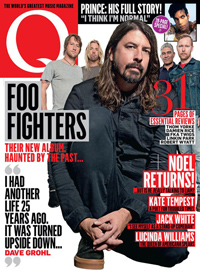The only cloud on Hawkins’s horizon is the telephonic presence of Q, about to ask some questions about the new Foo Fighters album. As a member of the Foo Fighters, Hawkins might seem well qualified to answer. Unfortunately for both Hawkins and Q, he has clearly been briefed not to discuss anything beyond the basic facts released thus far: that on 10 November, the Foo Fighters release a new album, Sonic Highways, featuring eight songs written and recorded in eight different American cities – Austin, Chicago, LA, Nashville, New Orleans, New York, Seattle and Washington, DC. According to the record company statement, each song features “local legends sitting in”. Q asks Taylor who the guests are. “You don’t know? Am I supposed to tell you?!” He laughs. “Why me? I always shit the bed! I was the first person to tell the world Dave Grohl was having his first kid and I didn’t even mean to. ‘No, I don’t think there’s any tours for a while cos Dave’s having a baby!’ He called me the next day: ‘You dumb-ass!’”
 So who are the guests?
So who are the guests?“Ahhhh… I’m not telling you! I don’t know if I can, dude!”
The sticking point is the “other” Sonic Highways: an eight-part series of documentaries, directed by Dave Grohl, each detailing through interviews with key figures the musical history of the same cities the Foo Fighters recorded in. With each song, Grohl wrote his lyrics at the 11th hour, “so as to be inspired by the experiences, interviews for the HBO series, and other local personalities who became part of the process”, the official statement says. One of these “local personalities” happens to be US President Barack Obama. The series premiered on 17 October; but for now, in late-September, every utterance the Foos make about their new LP is subject to a latticework of press embargoes.
Q attempts a speculative run through a list of the documentary interviewees, as well as those featured in HBO’s YouTube trailer, to wobble Hawkins’s wall of silence. Dolly Parton or Chuck D? “No.” Bad Brains? “No. Although Dave did jam with Bad Brains.” Gibby Haynes from Butthole Surfers? “No.” Rick Nielsen from Cheap Trick? “Uhhh… yes. Take another guess.” Allen Toussaint? “No. Wait… who’s Allen Toussaint?” He’s a famous New Orleans songwriter and producer. “Oh. No.” Carrie Underwood? “Uhhh… no.” Bonnie Raitt? “[Silence]… I’m not answering any more!” Joe Walsh? “Yes! Yes! OK, that’s your last one, that was your last guess! Shit, I hope I haven’t fucked up and given away too much information. I bet you I fucking did…”
Ten days later, Taylor
Hawkins finds himself
amid a sweaty cavern
built into disused
railway tunnels
underneath London’s
Waterloo Station. The
surroundings are less salubrious than his
Californian mansion, but he actually seems
more relaxed locking down the Foo Fighters’
hallmark euphoria. Technically, this isn’t a
Foo Fighters gig; the tickets and flyers claim
that the band playing this House Of Vans art
space-cum-skateboard bowl are called The
Holy Shits. But such is the Foo Fighters’
commercial footprint today, almost exactly
20 years since their original conception as the
vehicle for Dave Grohl’s musical journey
beyond the triumphs and trauma of Nirvana,
that any prospect of playing a venue with
a roof, let alone a capacity of just 600, has to
be veiled in subterfuge and pseudonym.
It’s a well-established Foos tradition
to preface a new album’s release with
secret gigs, invariably under an alias: on
3 September, 1999 at the Troubadour club in
West Hollywood, guitarist Chris Shiflett
made his debut Foo Fighters performance
masquerading as a member of Stacked Actors
whose set featured three songs from the twomonths-
imminent There Is Nothing Left To
Lose album. Yet despite Sonic Highways being
at precisely the same state of pre-release,
there are no new songs from The Holy Shits
at the House Of Vans. Ditto the previous
evening at Brighton’s Concorde 2, and the
next, at Islington Assembly Hall. Not even
a private performance for participants in
the Invictus Games, held in the grounds of
Winfield House in Regent’s Park, home of the
US Ambassador Matthew Barzun (a big Foo
Fighters fan, apparently), can persuade the
Foos/Shits to unveil any fresh material.
The only breaches in this pre-release
omerta come with a couple of instrumental
passages, dropped into
the performances of The
Pretender and This Is A
Call. No mention is made
of their root sources –
Outside and Something
From Nothing, two of the
most incandescent tracks
on the Sonic Highways album. Bat-eared
fans might just recognise the latter snippet
from a brief excerpt in HBO’s Sonic Highways
trailer. The unavoidable conclusion is that
Foo Fighters are being gagged by the
television network. Even Dave Grohl,
a man whose diplomatic skills are positively
ambassadorial, admits to feeling annoyed.
“It is frustrating,” he nods, sipping tea
with Q the day after the Foos have rocked
Brighton. “I can’t fucking wait to play these
new songs. But one of the elements of the TV
show is the reveal at the end. Our fear was
that if you hear the song before seeing the
show, it might give away the show. But yeah,
it’s tight. Very frustrating.”
In the same week of the Foo Fighters’
semi-incognito London residency, U2’s new
album is launched as the surprise package in
an Apple press conference. This the era of the
multi-platform and the big reveal, where the
frisson of viral marketing and unconventional
delivery schemes can render the actual
creative content irrelevant. Meanwhile, fear
of online leakage turns the average corporate
entertainment giant into an Orwellian nexus
of paranoia. Frustrated he may be, but Dave
Grohl understands that when the world’s
biggest rock group is so desperate to
maintain market profile that it gives
its new album to people whether
they want it or not, his role is as
much a brand curator as a band
leader. His response to the U2
business model is a diplomatic shrug.
“Weeelll, I wouldn’t want to judge,”
he smiles. “I just saw that as, ‘Oh, of
course…’ I don’t think you have to do
something like the TV show to make a
record. There’s still great records made by
people in their living rooms. But I think it’s
important to consider moving outside of that
and doing more. Yeah, ultimately, this is one
hell of a fucking machine that’s gonna spray
this album everywhere… but you have to
balance that with substance. More than a
reality show, more than a live concert series.
It’s part of the reason that we got deeper into
the concept, because we would love people
to learn as much as be entertained. But I can’t
imagine just going into a studio and making
another record. It seems so boring to me.”
He may have earned his musical spurs
drumming for Scream amid the politically
righteous Washington, DC hardcore scene
that coalesced around Ian MacKaye’s
Dischord House during the ’80s (MacKaye’s
record label featured in the second Sonic
Highways episode), but Dave Grohl has
always been more sympathiser than activist.
Although some of Sonic Highways’ guest
contributors might seem bizarre – the
Preservation Hall Jazz Band, for instance –
the album conforms to its architect’s wellestablished
template: sugar-coated, flarednostril,
punk rock classicism. So common
sense suggests that after 20 years and more
than a thousand gigs, the Foo Fighters engine
needs a regular tickle up, to keep both
audience and band alert at the wheel.
During the band’s first decade, this
process occurred in organic, if chaotic,
fashion via personnel crises: drummer
William Goldsmith left in 1997 and was
replaced by Taylor Hawkins; guitarist Pat
Smear departed later the same year, replaced
by Franz Stahl, who was himself replaced in
1999 by Chris Shiflett. But since Smear
returned to the fold in 2006 the line-up has
been steady, and so Grohl has deployed
external devices to refresh one of the most
successful formulas in modern rock. After
that hardy perennial stratagem of the
acoustic tour and album, Grohl took his
stadium-busting troupe back to basics with
2011’s Wasting Light, recorded on analogue
tape in his garage. He also invited a film crew,
resulting in the feature-length documentary
Back And Forth. Beyond being an effective
promotional tool, the movie provided
a revealing insight into the Foo Fighters’
collective personal chemistry.
“James Moll, the director, did such a good
job, because he didn’t focus on the super-fan
trivia, but on the emotional connection
between the people in the band,” says Grohl.
“It’s one of the reasons why it took the album
and the band to another place, because
people understood us as human beings.”
Duly inspired, Grohl made his directorial
debut with Sound City, from which the Sonic
Highways series is a logical next step.
Ostensibly a documentary about the studio
where Nirvana made Nevermind as told
through interviews with a cast of luminaries,
Sound City also functioned as an
advertisement for Grohl’s own Studio 606,
the scene of the film’s all-star jam sessions, as
well as affording yet more persuasive screen
time to the Grohl brand of Everyman decency,
the stuff that got him saddled with that Nicest
Man In Rock handle. In truth, Dave Grohl
didn’t get where he is today without knowing
how to take care of business; it’s just that
instead of securing loyalty through fear of
being sacked, he inspires his fellow travellers
by engendering a harmonious working
environment and leading by example.
In so doing, Grohl earns his bandmates’
acquiescence to aspects of the job they might
prefer to avoid. Taylor Hawkins, for instance,
hates spending so much of his working life
being filmed, as demanded by the Foo
Fighters’ most recent two albums.
“I fought the wearing of the live-on-air
mics,” he says. “Dave would get mad at me
sometimes if I wasn’t playing ball.” The
drummer’s misgivings echo those of
musicians from the ’80s when coerced by the
emergence of MTV into making promotional
videos. “I don’t wanna be on a reality TV
show,” says Hawkins. “It’s never been one of
my ambitions to be famous for being on TV.
But I think Dave’s on the money. It isn’t
purely business ambition, because I know he
truly loves to do this: a project, to stress and
not sleep, to figure out how to make it better.
He loves that process. Just as I, on a much
smaller level, like the process of recording a
song. That’s not enough for Dave any more.
No, I don’t like being filmed, but it is part of it
now. I was telling the drummer in Jane’s
Addiction, ‘You guys need to make the
gloves-off real-deal documentary, so people
realise how important you are.’ You can make
a great movie about any band that’s had
something.” He considers for a moment.
“The Oasis movie would be kind of amazing,
don’t you think? I’d watch it!”
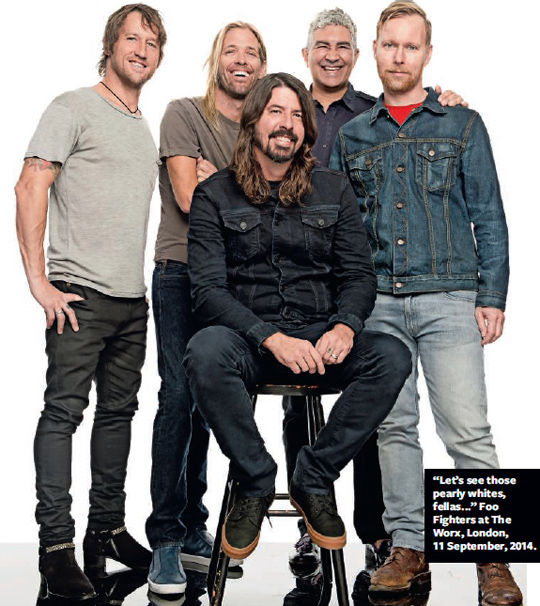
Wearing black patent
leather court shoes and
no socks, his face almost
perpetually amused,
there’s a decadent aura
about Pat Smear that
distinguishes him from
the other Foo Fighters. That and his age: at 55
he’s the eldest by at least 10 years. While his
bandmates enjoy typical all-American
outdoor pursuits, hiking and biking are not
his thing. On tour, he follows the same routine
regardless of city or country. “I stay in my
hotel room, usually with the curtains drawn,”
he says cheerily. “I never know where I am!”
Consequently, the Sonic Highways modus
operandi, which dictated spending six days
in each city, proved an eye-opener. Dave
Grohl’s criteria for choosing where to record
pinpointed places for which he and the others
felt a particular affinity – hence Chicago
(where the 13-year-old Grohl saw his first
gig), Washington, DC (near where Grohl
grew up in suburban Virginia) and Seattle
(Grohl’s hometown after joining Nirvana was
also where bassist Nate Mendel went to
university). LA was a logical choice, seeing as
all now live there, though only Smear can
truly consider himself a native. Of the
remaining four cities, Austin, Nashville and
New Orleans were chosen for the opposite
reason: the band had no obvious connections.
The LA experience was educational even
for Smear. Recording took place 90 minutes
outside the city, at Rancho De La Luna, the
home studio amid the high desert wilderness
of Joshua Tree famed for bacchanalian
sessions by Queens Of The Stone Age and
others. “I had never even been out in that
general area before,” says Smear. “So I didn’t
know what to expect. And it was not
something you could imagine, that’s for sure!”
As originally conceived, the Los Angeles
episode would begin in the city’s fleshpots
and then escape the glitz and glamour in
search of Joshua Tree’s frontier spirit. But
Grohl gradually realised that the pivotal
figure in the story was Smear himself, thanks
to his adventures as a dissolute teenager
on LA’s West Hollywood punk scene, where
he founded the Germs with the late Darby
Crash, a profound influence on the next
generation – most obviously Kurt Cobain, who
invited Smear to join Nirvana in 1993.
“I’ve known Pat for 20 years but
I don’t really ask him about the past,”
says Grohl. “For this episode we
walked around his old neighbourhood
and he told me about going to see the
Runaways for the first time, about the
history of the Germs, how he and Darby
met through a mutual speed dealer,
about meeting Alice Cooper and David
Bowie, chasing Freddie Mercury around
the Sunset Marquis Hotel… his life is so
extraordinary.”
All agree that New Orleans offered the
most otherworldly experience (“the only
place I was sad to leave,” says Smear), thanks
to its unique melting pot of European and
Caribbean cultures, the cityscape’s
omnipresent musical undertow – and, as
Hawkins observes, “the fact that everybody’s
pretty much half-drunk all the time.”
But in terms of deep emotional resonance,
the most keenly anticipated Sonic Highways
rendezvous ought to be Seattle. The band
recorded at Robert Lang Studios, a reputedly
haunted facility built into a cavern. The
resident spook wasn’t the only ghost in
attendance: Robert Lang’s hosted the last
Nirvana recording session, in January 1994,
shortly before Kurt Cobain’s death. It was
here also that Dave Grohl came later the same
year to record the debut Foo Fighters album,
playing every instrument himself. For Sonic
Highways, the band recorded a song called
Subterranean. The mood, according to
Hawkins, was sombre. “I had a dark feeling
about Seattle,” he says. “The song is dark
and sad, it’s about the end of something.”
“There’s a lot of history in Seattle,” adds
Mendel, “for Dave and the band. It’s a
dangerous place for us, in a way, just not a
really comfortable city. Kinda had to go there
– it made sense as a city to go and record in.
But obviously there’s the tragedy of what
happened with Nirvana. We started there,
but left. A lot of people have got personal
histories there that are kinda fractured.”
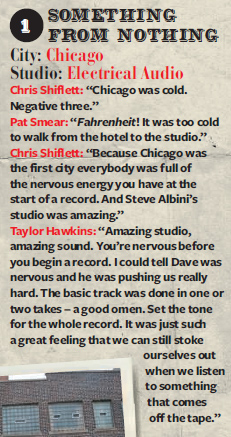
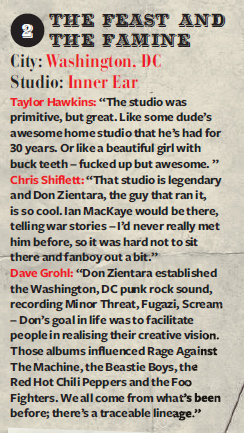
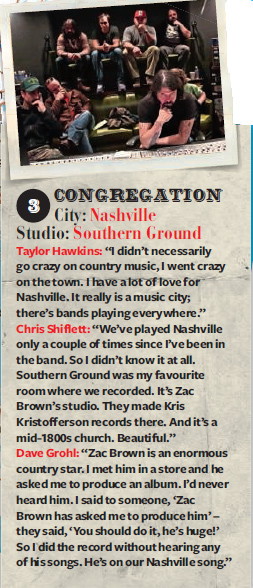
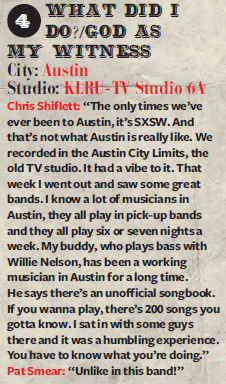
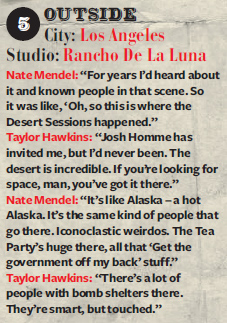
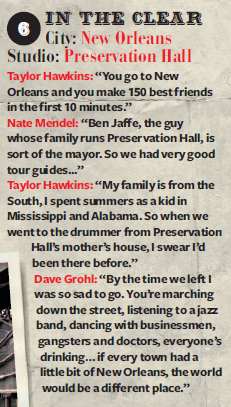
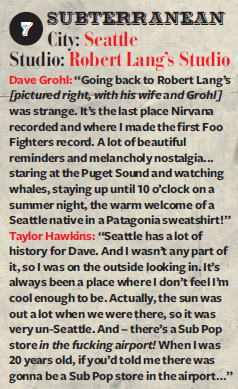
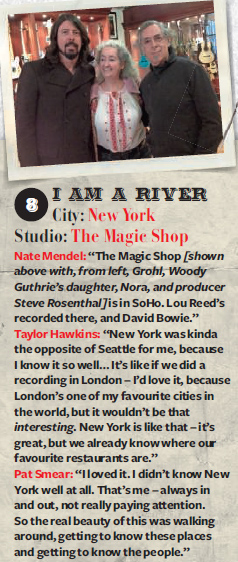
For all that the
Sonic Highways
concept dictated a
documentarian’s
perspective on lyrics,
Subterranean feels
autobiographical:
it’s impossible to hear Grohl deliver such
lines as “Nothing left within… I will start
again” or “You might think you know me
but I know damn well you don’t” and not feel
the singer’s personal connection.
“I still love Seattle,” he says. “I spent
wonderful years there. Every time I go, I rent
a car and I drive by myself to all the old places
I lived, or the coffee shops or the bars. I don’t
want to forget my past, because it’s part of
who I am and I need to remind myself of
those things, good and bad. That studio’s
right down the street from where I used to
live. I had another life 25 years ago. I was a kid
in one of the biggest bands in the world.
And then everything was turned upside
down. My life completely changed when Kurt
died. It gave me a whole new outlook on just
waking up every day. I learned then that’s
what happens when someone close to you
dies. You have to begin again. Almost every
single day I think about Kurt.”
The guest musician on Subterranean is
Death Cab For Cutie’s Ben Gibbard. Just 17
when Kurt Cobain died, in the documentary
he talks of how his mother broke the news.
“She came into his bedroom, sat down next
to him, rubbed his back and told him,” says
Grohl. “He remembers breaking down,
and in the interview he starts to break down.
He said that day at school, all the freaks and
the punks and the nerds and the geeks had
a day off from the jocks bullying them. The
assholes left the Nirvana kids alone. What
a wonderful story. That meant a lot to me.”
Ten days after the Foo Fighters closed the
Invictus Games in London, Dave Grohl is
where you’ll usually find him when he’s not
on the road: at Studio 606, benevolent
master of all he surveys. It’s a rehearsal day
and Grohl taps his feet in anticipation as the
Foos’ crew check the gear and his bandmates
move into position. The clock says 10am but
he’s been on the go for hours, and not just
because the Grohl household got a new
member in August when his wife Jordyn gave
birth to baby Ophelia, the family’s third
daughter. “I’ve already had my pot of coffee
before the sun comes up,” he smiles.
His latest caffeinated brainwave is a
20th-anniversary re-enactment of the first
Foo Fighters tour, which saw the original
quartet supporting Mike Watt at such
storied entertainment palaces as the Dingo
Bar in Albuquerque and the Philadelphia
Trocadero. Not only does Grohl intend to
play the same venues, he insists the band will
use the same tiny van. Although nowadays
accustomed to executive class, he insists
this won’t be a problem. “We still like each
other. Still to this day, if the band needs to be
somewhere and three vans show up to drive
us, we all get in the one van.”
The feet tap. Last week he was editing the
LA Sonic Highways episode. Yesterday he was
at Apple’s headquarters. Doing what, one
wonders? “Oh, just talking! If there’s one
thing I’m excited about it’s spreading the
message of what we’ve been doing for the last
two years.” At Apple, he said hello to Jony Ive,
the London-born designer responsible for
every revolutionary device the company have
introduced. “Jony, how much do you sleep?”
Grohl asked. “I’m much better now,” replied
Ive. “Maybe five or six hours a night…”
“I went, ‘Wow, lucky bastard…!’” Grohl
laughs. “I make music because I wake up in
the morning like a fucking Space Shuttle, and
just start roaring. Every… single… fucking…
day. Within an hour and a half I have an
instrument in my hand.” He waves at his
fellow musicians, now regarding him
expectantly. “I feel a responsibility to do this.
When I look at Ian Beveridge, our monitor
guy, who’s been working with me for 25 years.
Or I look at Taylor Hawkins, or I look at Pat
Smear, or I look at the 40,000 people who
come to see the band play in a field, I don’t
want to let them down. All those people. I’m
here for them. Because what the fuck else am
I gonna do? Make movies?! Can you imagine
me trying to direct some pretentious male
model to emote?! Believe me, if there’s
a hell on earth, I think that might be it.”
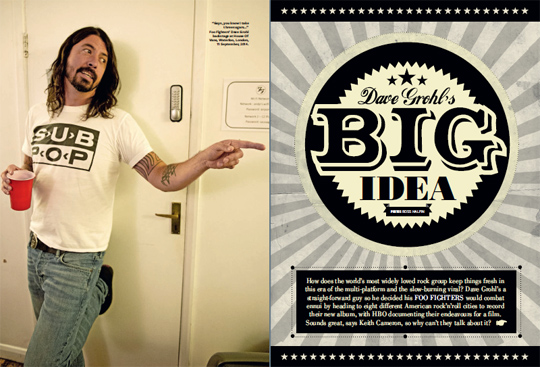
History suggests we should hold him to that promise. For whichever Hollywood hotshot makes the documentary of Dave Grohl’s life, the title ought to be Expect The Unexpected: how a high-school drop-out, Nirvana’s self-styled “skinny muppet at the back banging shit”, became the guitarist, songwriter and life force of one of the world’s greatest rock bands, in the process confounding everyone’s expectations. Except his own. Twenty-five years down this personal sonic highway, a route that’s taken him from the Dischord House to the White House, Dave Grohl’s journey is far from over.
Words: Keith Cameron Pics: Ross Halfin
